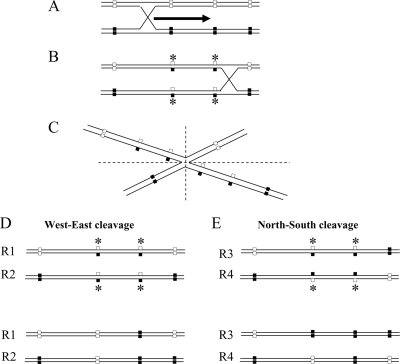FIG. 4.
Schematic representation of gene conversion occurring in the heteroduplex region formed during homologous recombination. (A) The two parental DNA molecules (P1 and P2) are aligned before recombination. The initial CO takes place by an exchange of single strands between the parental DNAs. (B) Once the cross-bridge has formed, its position can diffuse along the paired molecules. This process can create long regions of heteroduplex DNA. Mismatched positions in the heteroduplex are indicated by asterisks. (C) The Holliday structure can be redrawn, as indicated in B, after a rotation of 180° around the cross-bridge. The Holliday structure might be resolved either by West-East or by North-South cuts. (D) West-East cut yields linear molecules that are not recombinant for external genetic markers. However, repairs of mismatches within heteroduplex-combining alleles of the two parental DNAs might create apparent double recombinants through gene conversion in favor of one of the parental templates. (E) North-South cut yields linear molecules that are recombinant for parental genetic markers on either side of heteroduplex. Repairs of mismatches might also create multiple recombinants (R4) through gene conversion.

